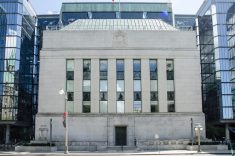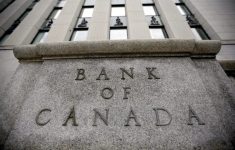Ottawa | Reuters — Canada’s annual inflation rate in May was unchanged from the previous month at 1.7 per cent as a drop in gasoline costs continued to keep the overall index stable while prices of shelter, food and transportation also cooled, data showed on Tuesday.
There are concerns that a raft of tariffs imposed by Trump on steel, aluminum and automobiles exported to the U.S. from Canada and subsequent counter-measures from Canada would increase prices across the board.
Read Also

U.S. grains: Soy futures set 15-month high after China agrees to purchases
U.S. soybean futures reached a 15-month high on Thursday after President Donald Trump’s administration said top-importer China agreed to buy tens of millions of tons of American crops in the next few years as part of a trade truce.
Those fears have not been reflected in the headline consumer price index as a tax removal on gasoline from April is expected to keep the cost at the pump down for a year. Mortgage costs and rents have also consistently eased.
Analysts surveyed by Reuters had expected annual inflation in May to be at 1.7 per cent and monthly inflation at 0.5 per cent.
StatsCan said inflation in May on a monthly basis was at 0.6 per cent, largely led by a seasonal increase in travel, accommodation and energy costs.
Gasoline prices decelerated by 15.5 per cent in May after falling by 18.1 per cent in April on an annual basis.
The cost of shelter component of the CPI, which has the biggest weight of 30 per cent in the overall basket, grew by three per cent in May, down from 3.4 per cent in April, as both mortgage interest costs and rents eased.
The Bank of Canada closely tracks core measures of inflation – CPI-trim and CPI-median – and both of them eased to three per cent, which is the upper band of the central bank’s one per cent to three per cent inflation target range.
The May and June inflation data are critical for BoC’s rates decision on July 30. If inflation continues to be low, it could tilt the bank towards a rate cut. The bank will also get April’s GDP report before its next meeting.
“This piles a lot of pressure on to the upcoming GDP report,” said Andrew Kelvin, Chief Canada Strategist at TD Securities, adding that if the economy slows materially in April, there could be a possibility of a rate cut.
After cutting rates aggressively and consistently for nine months since June last year by 225 basis points to 2.75 per cent, it has paused its rate reduction cycle at its last two meetings, especially due to the uncertainty hanging around tariffs.
Money markets are betting around a 68 per cent chance of yet another hold by the central bank of its policy rate at 2.75 per cent on July 30, when it also releases its monetary policy report.
The Canadian dollar weakened slightly after the data and was trading up 0.1 per cent to 1.3717 against the U.S. dollar, or 72.90 U.S. cents. Yields on the government’s two-year bonds were up 2.4 basis points to 2.637 per cent.
— Additional reporting by Nivedita Balu and Fergal Smith in Toronto











